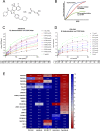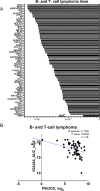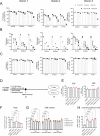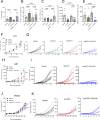IOA-244 is a Non-ATP-competitive, Highly Selective, Tolerable PI3K Delta Inhibitor That Targets Solid Tumors and Breaks Immune Tolerance
- PMID: 37066023
- PMCID: PMC10103717
- DOI: 10.1158/2767-9764.CRC-22-0477
IOA-244 is a Non-ATP-competitive, Highly Selective, Tolerable PI3K Delta Inhibitor That Targets Solid Tumors and Breaks Immune Tolerance
Abstract
PI3K delta (PI3Kδ) inhibitors are used to treat lymphomas but safety concerns and limited target selectivity curbed their clinical usefulness. PI3Kδ inhibition in solid tumors has recently emerged as a potential novel anticancer therapy through the modulation of T-cell responses and direct antitumor activity. Here we report the exploration of IOA-244/MSC2360844, a first-in-class non-ATP-competitive PI3Kδ inhibitor, for the treatment of solid tumors. We confirm IOA-244's selectivity as tested against a large set of kinases, enzymes, and receptors. IOA-244 inhibits the in vitro growth of lymphoma cells and its activity correlates with the expression levels of PIK3CD, suggesting cancer cell-intrinsic effects of IOA-244. Importantly, IOA-244 inhibits regulatory T cell proliferation while having limited antiproliferative effects on conventional CD4+ T cells and no effect on CD8+ T cells. Instead, treatment of CD8 T cells with IOA-244 during activation, favors the differentiation of memory-like, long-lived CD8, known to have increased antitumor capacity. These data highlight immune-modulatory properties that can be exploited in solid tumors. In CT26 colorectal and Lewis lung carcinoma lung cancer models, IOA-244 sensitized the tumors to anti-PD-1 (programmed cell death protein 1) treatment, with similar activity in the Pan-02 pancreatic and A20 lymphoma syngeneic mouse models. IOA-244 reshaped the balance of tumor-infiltrating cells, favoring infiltration of CD8 and natural killer cells, while decreasing suppressive immune cells. IOA-244 presented no detectable safety concerns in animal studies and is currently in clinical phase Ib/II investigation in solid and hematologic tumors.
Significance: IOA-244 is a first-in-class non-ATP-competitive, PI3Kδ inhibitor with direct antitumor in vitro activity correlated with PI3Kδ expression. The ability to modulate T cells, in vivo antitumor activity in various models with limited toxicity in animal studies provides the rationale for the ongoing trials in patients with solid tumors and hematologic cancers.
© 2023 The Authors; Published by the American Association for Cancer Research.
Figures




Similar articles
-
Parsaclisib Is a Next-Generation Phosphoinositide 3-Kinase δ Inhibitor with Reduced Hepatotoxicity and Potent Antitumor and Immunomodulatory Activities in Models of B-Cell Malignancy.J Pharmacol Exp Ther. 2020 Jul;374(1):211-222. doi: 10.1124/jpet.120.265538. Epub 2020 Apr 28. J Pharmacol Exp Ther. 2020. PMID: 32345620
-
Phosphoinositide 3-kinase δ inhibition promotes antitumor responses but antagonizes checkpoint inhibitors.JCI Insight. 2018 Jun 7;3(11):e120626. doi: 10.1172/jci.insight.120626. eCollection 2018 Jun 7. JCI Insight. 2018. PMID: 29875319 Free PMC article.
-
SHC014748M, a novel selective inhi-bitor of PI3Kδ, demonstrates promising preclinical antitumor activity in B cell lymphomas and chronic lymphocytic leukemia.Neoplasia. 2020 Dec;22(12):714-724. doi: 10.1016/j.neo.2020.10.004. Epub 2020 Oct 23. Neoplasia. 2020. PMID: 33142237 Free PMC article.
-
Platinum-based chemotherapy in combination with PD-1/PD-L1 inhibitors: preclinical and clinical studies and mechanism of action.Expert Opin Drug Deliv. 2021 Feb;18(2):187-203. doi: 10.1080/17425247.2021.1825376. Epub 2020 Oct 5. Expert Opin Drug Deliv. 2021. PMID: 32954856 Review.
-
A Review of Phosphocreatine 3 Kinase δ Subtype (PI3Kδ) and Its Inhibitors in Malignancy.Med Sci Monit. 2021 Oct 9;27:e932772. doi: 10.12659/MSM.932772. Med Sci Monit. 2021. PMID: 34625526 Free PMC article. Review.
Cited by
-
Targeting T regulatory (Treg) cells in immunotherapy-resistant cancers.Cancer Drug Resist. 2024 Jan 12;7:2. doi: 10.20517/cdr.2023.46. eCollection 2024. Cancer Drug Resist. 2024. PMID: 38318526 Free PMC article. Review.
-
SBL-JP-0004: A promising dual inhibitor of JAK2 and PI3KCD against gastric cancer.Oncol Res. 2024 Dec 20;33(1):235-243. doi: 10.32604/or.2024.055677. eCollection 2025. Oncol Res. 2024. PMID: 39735669 Free PMC article.
-
A novel mitochondrial pyruvate carrier inhibitor drives stem cell-like memory CAR T cell generation and enhances antitumor efficacy.Mol Ther Oncol. 2024 Oct 18;32(4):200897. doi: 10.1016/j.omton.2024.200897. eCollection 2024 Dec 19. Mol Ther Oncol. 2024. PMID: 39559715 Free PMC article.
-
Non-Clinical Toxicology Evaluation of the Novel Non-ATP Competitive Oral PI3 Kinase Delta Inhibitor Roginolisib.Int J Toxicol. 2023 Dec;42(6):515-534. doi: 10.1177/10915818231200419. Epub 2023 Sep 4. Int J Toxicol. 2023. PMID: 37667445 Free PMC article.
-
The microtubule-targeted agent lisavanbulin (BAL101553) shows anti-tumor activity in lymphoma models.Am J Cancer Res. 2023 May 15;13(5):2076-2086. eCollection 2023. Am J Cancer Res. 2023. PMID: 37293172 Free PMC article.
References
Publication types
MeSH terms
Substances
LinkOut - more resources
Full Text Sources
Other Literature Sources
Medical
Molecular Biology Databases
Research Materials
Miscellaneous

